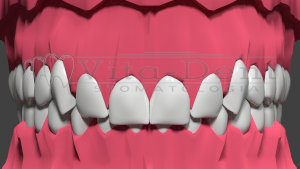
Treatment with a solid metal apparatus
Solid metal cameras are a proven way to make straight teeth.

Metal orthodontic apparatus
Metal orthodontic camera is more durable than a fixed aesthetic camera

Fixed metal camera
The metal camera is physically smaller than the aesthetic camera
Vertical bite defects
When analyzing teeth, orthodontise always evaluates diagnostic models in each plane. Vertical irregularities, we call deviations relative to the horizontal plane. Vertical defects are among the very difficult to treat hypertrophic disorders, skeletal, habitual, habitual or combinations thereof. The basic division of vertical defects contains deep bites and open bites.
Deep bite
The deep bite is characterized by an enlarged bite of the sieve teeth. With a high severity of defects, grated teeth completely overlap the lower teeth, often additionally causing periodontal disease. Early diagnosis of excessive vertical bite can greatly facilitate treatment. To learn more about deep bite, take a look at our deep bite subpage –
Deep bite
Open bite
The open bite is characterized by a negative bite. In other words, this is a situation where the upper and lower teeth do not connect to each other after a bite. Depending on where the defect is manifested, we distinguish:
- Bite open front
- Bite open side
Another way of classification is to delimit to:
- Open tooth bite
- Open skeletal bite
More information about the open bite can be found on the subpage –
Open bite
Vertical orthodontic defects – FREQUENTLY ASKED QUESTIONS:

- Can vertical defects coexist with other orthodontic disorders? Yes, the teeth of the jaw and mandibles naturally interact with each other. Often, a disorder in one plane leads to irregularities in other planes. Often a co-occurring drawback of the open bite is insufficient development of the jaw, manifested by a narrow palate, resulting in a cross bite.
- I have a severe form of the defect, can I be treated only surgically? Patients for whom traditional treatment is impossible are eligible for surgical treatment. In an age of progress over recent years, conventional orthodontic treatment helps a much larger number of patients than in the past. The development of bone infection in the form of miniplatelets or orthodontic miniimplants allows for satisfactory treatment of almost any bite defect. Each patient is subjected to individual analysis, which are aimed at optimal treatment results. Due to quality-targeted therapy, it is sometimes worth undergoing surgery to achieve the intended improvement in quality and comfort of life.





